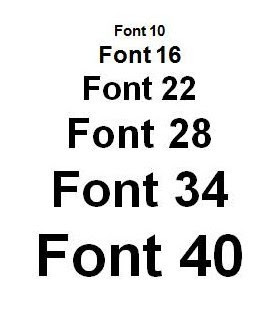Decoding 10-Point Font: Size, Inches, and Why It Matters
Ever squinted at a document, wrestling with minuscule text? Or perhaps felt overwhelmed by gargantuan letters dominating a page? Font size, a seemingly mundane detail, wields surprising power over our reading experience. This deep dive explores the ubiquitous 10-point font, its dimensions in inches, and its impact on how we consume information.
Understanding the physical size of a 10-point font—roughly 0.138 inches or 3.51mm—is only the starting point. While a point nominally equates to 1/72 of an inch, the actual rendered size can fluctuate slightly depending on the font, software, and even operating system. This seemingly minute variation can significantly impact readability, particularly for extensive documents or those with visual impairments.
The prevalence of 10-point font stems from its balance between readability and space efficiency. Historically, standard print media like newspapers and books often employed this size, making it a familiar and comfortable choice for many readers. In the digital realm, 10-point font remains a popular default setting, a testament to its enduring legacy.
But the seemingly innocuous 10-point font carries its own set of complexities. Its suitability depends heavily on the context: a 10-point Times New Roman may appear significantly smaller than a 10-point Arial due to the fonts' inherent design differences. Screen resolution, viewing distance, and ambient lighting also play a crucial role in how we perceive this font size. Ignoring these factors can lead to accessibility issues, hindering information access for some users.
Beyond the technicalities, there's a human element to consider. The perceived size of 10-point font can be influenced by individual factors like visual acuity and age. What's comfortable for one reader might strain another. Understanding this subjectivity is critical, especially when designing content for a diverse audience.
While quantifying the precise inch equivalent of a 10-point font is challenging due to variations across platforms and fonts, it's generally accepted to be approximately 0.138 inches. This translates to about 3.5 millimeters. Keep in mind this is a rough guide, and actual rendered sizes may deviate slightly.
Historically, point sizes originated within the printing industry. While the exact origins remain somewhat obscure, the point system provided a standardized method for measuring type sizes, ensuring consistency across different printing presses and publications.
Advantages and Disadvantages of 10-Point Font
| Advantages | Disadvantages |
|---|---|
| Commonly considered readable for most people | Can be too small for some individuals with visual impairments |
| Relatively space-efficient | Might feel cramped in large blocks of text |
| Familiar and widely used | Variability in rendering across different devices and fonts |
Best Practices:
1. Test your content on various devices and browsers to ensure consistent rendering of the font.
2. Offer users the ability to adjust font size for personalized reading experiences.
3. Consider using slightly larger font sizes for body text, especially on screens.
4. Prioritize clear, legible fonts over overly stylistic choices.
5. Maintain sufficient line spacing and white space to enhance readability.
FAQs:
1. What is the approximate size of a 10-point font in inches? Approximately 0.138 inches.
2. Why does the size of a 10-point font sometimes seem to vary? Variations occur due to differences in fonts, operating systems, and rendering engines.
3. Is 10-point font suitable for all users? Not necessarily; users with visual impairments might require larger font sizes.
4. How can I improve the readability of 10-point font? Use clear fonts, ample line spacing, and sufficient white space.
5. What is the history of the point system for fonts? It originated in the printing industry for standardized type measurement.
6. What are some alternatives to 10-point font for enhanced accessibility? Consider 12-point or larger fonts for body text.
7. How do different fonts affect the perceived size of a 10-point font? Some fonts appear larger or smaller than others at the same point size due to design characteristics.
8. What are the benefits of using 10-point font in print media? Space efficiency and established readability conventions.
Tips and Tricks:
Experiment with different fonts to find ones that appear larger and more legible at 10-point. Utilize online font size converters to get a better understanding of point-to-inch conversions for specific fonts.
In conclusion, the 10-point font, with its approximate size of 0.138 inches, remains a prevalent standard in both print and digital media. However, its effectiveness hinges on careful consideration of context, user needs, and best practices. By understanding the nuances of this common font size and its impact on readability, designers and content creators can craft materials that are both accessible and engaging. Prioritizing user experience and employing the strategies outlined here will ensure that your message is clearly communicated, regardless of the font size you choose. Take the time to test, adapt, and refine your content to ensure optimal readability for everyone. By understanding the interplay between point size, inches, and user perception, we can harness the power of typography to create a more inclusive and accessible information landscape. This attention to detail ultimately empowers users to engage with content comfortably and effectively.
The enduring power of a picture of man in gas mask
Mother and 3 child tattoo designs a touching tribute
Upgrade your bathroom steam showers and bathtub enclosures














